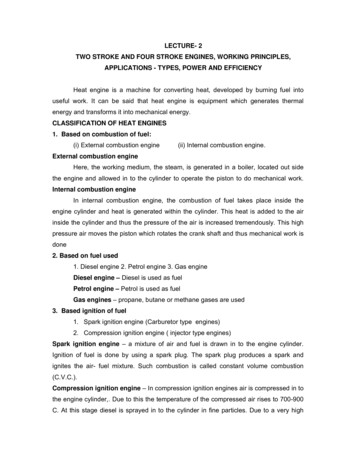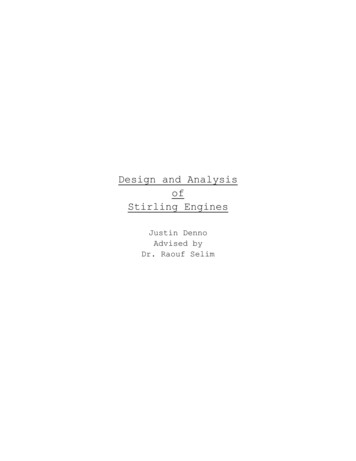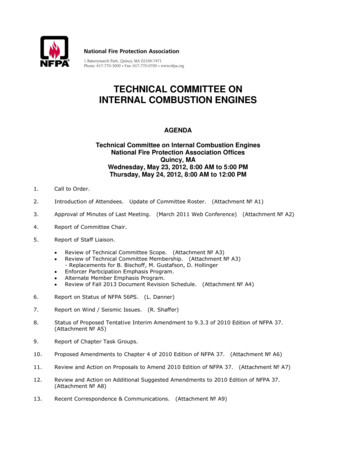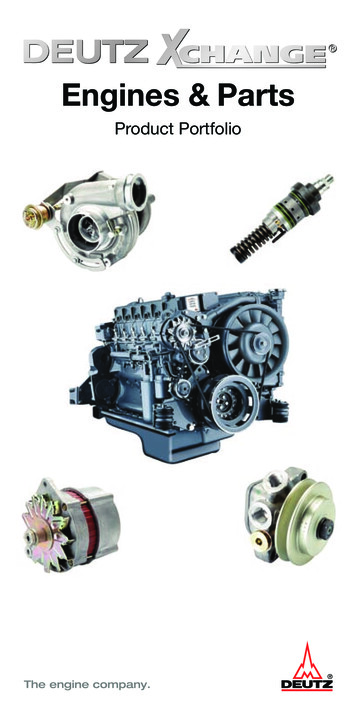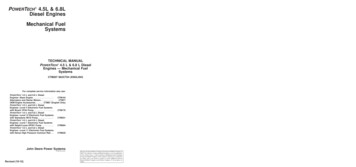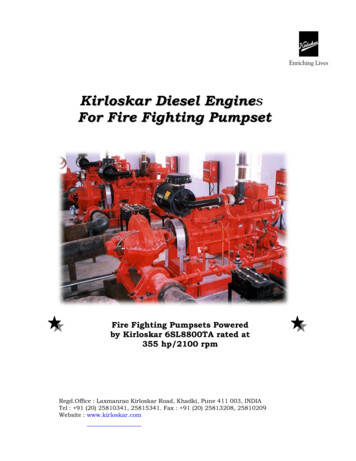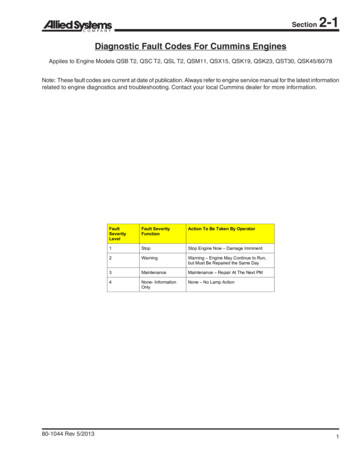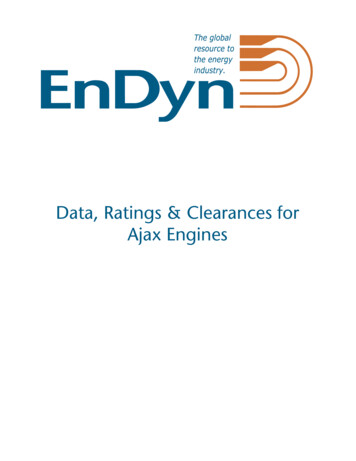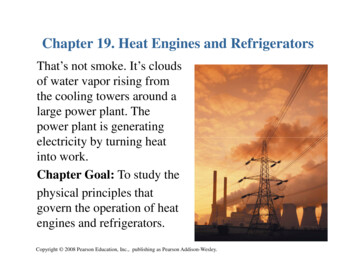
Transcription
Chapter 19. Heat Engines and RefrigeratorsThat’s not smoke. It’s cloudsof water vapor rising fromthe cooling towers around alarge power plant. Thepower plant is generatingelectricity by turning heatinto work.Chapter Goal: To study thephysical principles thatgovern the operation of heatengines and refrigerators.Copyright 2008 Pearson Education, Inc., publishing as Pearson Addison-Wesley.
Chapter 19. Heat Engines and RefrigeratorsTopics: Turning Heat into Work Heat Engines and Refrigerators Ideal-Gas Heat Engines Ideal-Gas Refrigerators The Limits of Efficiency The Carnot CycleCopyright 2008 Pearson Education, Inc., publishing as Pearson Addison-Wesley.
Chapter 19. Reading QuizzesCopyright 2008 Pearson Education, Inc., publishing as Pearson Addison-Wesley.
What is the generic name for acyclical device that transforms heatenergy into work?A. RefrigeratorB. Thermal motorC. Heat engineD. Carnot cycleE. Otto processorCopyright 2008 Pearson Education, Inc., publishing as Pearson Addison-Wesley.
What is the generic name for acyclical device that transforms heatenergy into work?A. RefrigeratorB. Thermal motorC. Heat engineD. Carnot cycleE. Otto processorCopyright 2008 Pearson Education, Inc., publishing as Pearson Addison-Wesley.
The area enclosed within a pV curve isA. the work done by the system during onecomplete cycle.B. the work done on the system during onecomplete cycle.C. the thermal energy change of the system duringone complete cycle.D. the heat transferred out of the system during onecomplete cycle.Copyright 2008 Pearson Education, Inc., publishing as Pearson Addison-Wesley.
The area enclosed within a pV curve isA. the work done by the system during onecomplete cycle.B. the work done on the system during onecomplete cycle.C. the thermal energy change of the system duringone complete cycle.D. the heat transferred out of the system during onecomplete cycle.Copyright 2008 Pearson Education, Inc., publishing as Pearson Addison-Wesley.
The maximum possibleefficiency of a heat engine isdetermined byA. its design.B. the amount of heat that flows.C. the maximum and minimum pressure.D. the compression ratio.E. the maximum and minimum temperature.Copyright 2008 Pearson Education, Inc., publishing as Pearson Addison-Wesley.
The maximum possibleefficiency of a heat engine isdetermined byA. its design.B. the amount of heat that flows.C. the maximum and minimum pressure.D. the compression ratio.E. the maximum and minimum temperature.Copyright 2008 Pearson Education, Inc., publishing as Pearson Addison-Wesley.
The engine with the largest possibleefficiency uses aA. Brayton cycle.B. Joule cycle.C. Carnot cycle.D. Otto cycle.E. Diesel cycle.Copyright 2008 Pearson Education, Inc., publishing as Pearson Addison-Wesley.
The engine with the largest possibleefficiency uses aA. Brayton cycle.B. Joule cycle.C. Carnot cycle.D. Otto cycle.E. Diesel cycle.Copyright 2008 Pearson Education, Inc., publishing as Pearson Addison-Wesley.
Chapter 19. Basic Content and ExamplesCopyright 2008 Pearson Education, Inc., publishing as Pearson Addison-Wesley.
Turning Heat into Work Thermodynamics is the branch of physics that studies thetransformation of energy. Many practical devices are designed to transform energyfrom one form, such as the heat from burning fuel, intoanother, such as work. Chapters 17 and 18 established two laws of thermodynamicsthat any such device must obey.Copyright 2008 Pearson Education, Inc., publishing as Pearson Addison-Wesley.
Heat Engines A heat engine is any closed-cycle device that extractsheat from a hot reservoir, does useful work, and exhaustsheat to a cold reservoir. A closed-cycle device is one that periodically returns to itsinitial conditions, repeating the same process overand over. All state variables (pressure, temperature, thermal energy,and so on) return to their initial values once every cycle. A heat engine can continue to do useful work for as longas it is attached to the reservoirs.Copyright 2008 Pearson Education, Inc., publishing as Pearson Addison-Wesley.
Heat EnginesCopyright 2008 Pearson Education, Inc., publishing as Pearson Addison-Wesley.
Heat EnginesFor practical reasons, we would like an engine to do themaximum amount of work with the minimum amount offuel. We can measure the performance of a heat engine interms of its thermal efficiency η (lowercase Greek eta),defined asWe can also write the thermal efficiency asCopyright 2008 Pearson Education, Inc., publishing as Pearson Addison-Wesley.
Copyright 2008 Pearson Education, Inc., publishing as Pearson Addison-Wesley.
Copyright 2008 Pearson Education, Inc., publishing as Pearson Addison-Wesley.
EXAMPLE 19.1 Analyzing a heat engine IQUESTION:Copyright 2008 Pearson Education, Inc., publishing as Pearson Addison-Wesley.
EXAMPLE 19.1 Analyzing a heat engine ICopyright 2008 Pearson Education, Inc., publishing as Pearson Addison-Wesley.
EXAMPLE 19.1 Analyzing a heat engine ICopyright 2008 Pearson Education, Inc., publishing as Pearson Addison-Wesley.
EXAMPLE 19.1 Analyzing a heat engine ICopyright 2008 Pearson Education, Inc., publishing as Pearson Addison-Wesley.
EXAMPLE 19.1 Analyzing a heat engine ICopyright 2008 Pearson Education, Inc., publishing as Pearson Addison-Wesley.
EXAMPLE 19.1 Analyzing a heat engine ICopyright 2008 Pearson Education, Inc., publishing as Pearson Addison-Wesley.
EXAMPLE 19.1 Analyzing a heat engine ICopyright 2008 Pearson Education, Inc., publishing as Pearson Addison-Wesley.
EXAMPLE 19.1 Analyzing a heat engine ICopyright 2008 Pearson Education, Inc., publishing as Pearson Addison-Wesley.
EXAMPLE 19.1 Analyzing a heat engine ICopyright 2008 Pearson Education, Inc., publishing as Pearson Addison-Wesley.
EXAMPLE 19.1 Analyzing a heat engine ICopyright 2008 Pearson Education, Inc., publishing as Pearson Addison-Wesley.
Problem-Solving Strategy: Heat-EngineProblemsCopyright 2008 Pearson Education, Inc., publishing as Pearson Addison-Wesley.
Problem-Solving Strategy: Heat-EngineProblemsCopyright 2008 Pearson Education, Inc., publishing as Pearson Addison-Wesley.
Problem-Solving Strategy: Heat-EngineProblemsCopyright 2008 Pearson Education, Inc., publishing as Pearson Addison-Wesley.
Problem-Solving Strategy: Heat-EngineProblemsCopyright 2008 Pearson Education, Inc., publishing as Pearson Addison-Wesley.
Problem-Solving Strategy: Heat-EngineProblemsCopyright 2008 Pearson Education, Inc., publishing as Pearson Addison-Wesley.
Refrigerators Understanding a refrigerator is a little harder thanunderstanding a heat engine. Heat is always transferred from a hotter object to acolder object. The gas in a refrigerator can extract heat QC from thecold reservoir only if the gas temperature is lower thanthe cold-reservoir temperature TC. Heat energy is thentransferred from the cold reservoir into the colder gas. The gas in a refrigerator can exhaust heat QH tothe hot reservoir only if the gas temperature is higherthan the hot-reservoir temperature TH. Heat energy isthen transferred from the warmer gas into the hotreservoir.Copyright 2008 Pearson Education, Inc., publishing as Pearson Addison-Wesley.
RefrigeratorsCopyright 2008 Pearson Education, Inc., publishing as Pearson Addison-Wesley.
RefrigeratorsCopyright 2008 Pearson Education, Inc., publishing as Pearson Addison-Wesley.
RefrigeratorsCopyright 2008 Pearson Education, Inc., publishing as Pearson Addison-Wesley.
EXAMPLE 19.3 Analyzing a refrigeratorQUESTION:Copyright 2008 Pearson Education, Inc., publishing as Pearson Addison-Wesley.
EXAMPLE 19.3 Analyzing a refrigeratorCopyright 2008 Pearson Education, Inc., publishing as Pearson Addison-Wesley.
EXAMPLE 19.3 Analyzing a refrigeratorCopyright 2008 Pearson Education, Inc., publishing as Pearson Addison-Wesley.
EXAMPLE 19.3 Analyzing a refrigeratorCopyright 2008 Pearson Education, Inc., publishing as Pearson Addison-Wesley.
EXAMPLE 19.3 Analyzing a refrigeratorCopyright 2008 Pearson Education, Inc., publishing as Pearson Addison-Wesley.
EXAMPLE 19.3 Analyzing a refrigeratorCopyright 2008 Pearson Education, Inc., publishing as Pearson Addison-Wesley.
EXAMPLE 19.3 Analyzing a refrigeratorCopyright 2008 Pearson Education, Inc., publishing as Pearson Addison-Wesley.
EXAMPLE 19.3 Analyzing a refrigeratorCopyright 2008 Pearson Education, Inc., publishing as Pearson Addison-Wesley.
The Limits of EfficiencyEveryone knows that heat can produce motion. That itpossesses vast motive power no one can doubt, inthese days when the steam engine is everywhere so wellknown. . . . Notwithstanding the satisfactory condition towhich they have been brought today, their theory is verylittle understood. The question has often been raisedwhether the motive power of heat is unbounded, orwhether the possible improvements in steam engineshave an assignable limit.Sadi CarnotCopyright 2008 Pearson Education, Inc., publishing as Pearson Addison-Wesley.
The Limits of EfficiencyA perfectly reversible engine must use only two types ofprocesses:1. Frictionless mechanical interactions with noheat transfer (Q 0)2. Thermal interactions in which heat is transferred inan isothermal process ( Eth 0).Any engine that uses only these two types of processes iscalled a Carnot engine.A Carnot engine is a perfectly reversible engine; it has themaximum possible thermal efficiency ηmax and, ifoperated as a refrigerator, the maximum possiblecoefficient of performance Kmax.Copyright 2008 Pearson Education, Inc., publishing as Pearson Addison-Wesley.
The Carnot CycleThe Carnot cycle is anideal-gas cycle that consistsof the two adiabaticprocesses (Q 0) and thetwo isothermal processes( Eth 0) shown.These are the two types ofprocesses allowed in aperfectly reversible gasengine.Copyright 2008 Pearson Education, Inc., publishing as Pearson Addison-Wesley.
The Carnot CycleAs a Carnot cycle operates,1. The gas is isothermally compressed at TC. Heat energy QC Q12 is removed.2. The gas is adiabatically compressed, with Q 0, untilthe gas temperature reaches TH.3. After reaching maximum compression, the gasexpands isothermally at temperature TH. Heat QH Q34 istransferred into the gas.4. The gas expands adiabatically, with Q 0, untilthe temperature decreases back to TC.Work is done in all four processes of the Carnot cycle, but heatis transferred only during the two isothermal processes.Copyright 2008 Pearson Education, Inc., publishing as Pearson Addison-Wesley.
The Maximum EfficiencyCopyright 2008 Pearson Education, Inc., publishing as Pearson Addison-Wesley.
EXAMPLE 19.6 Brayton versus CarnotCopyright 2008 Pearson Education, Inc., publishing as Pearson Addison-Wesley.
EXAMPLE 19.6 Brayton versus CarnotCopyright 2008 Pearson Education, Inc., publishing as Pearson Addison-Wesley.
EXAMPLE 19.6 Brayton versus CarnotCopyright 2008 Pearson Education, Inc., publishing as Pearson Addison-Wesley.
EXAMPLE 19.7 Generating electricityQUESTION:Copyright 2008 Pearson Education, Inc., publishing as Pearson Addison-Wesley.
EXAMPLE 19.7 Generating electricityCopyright 2008 Pearson Education, Inc., publishing as Pearson Addison-Wesley.
EXAMPLE 19.7 Generating electricityCopyright 2008 Pearson Education, Inc., publishing as Pearson Addison-Wesley.
EXAMPLE 19.7 Generating electricityCopyright 2008 Pearson Education, Inc., publishing as Pearson Addison-Wesley.
Chapter 19. Summary SlidesCopyright 2008 Pearson Education, Inc., publishing as Pearson Addison-Wesley.
General PrinciplesCopyright 2008 Pearson Education, Inc., publishing as Pearson Addison-Wesley.
General PrinciplesCopyright 2008 Pearson Education, Inc., publishing as Pearson Addison-Wesley.
Important ConceptsCopyright 2008 Pearson Education, Inc., publishing as Pearson Addison-Wesley.
Important ConceptsCopyright 2008 Pearson Education, Inc., publishing as Pearson Addison-Wesley.
Important ConceptsCopyright 2008 Pearson Education, Inc., publishing as Pearson Addison-Wesley.
ApplicationsCopyright 2008 Pearson Education, Inc., publishing as Pearson Addison-Wesley.
Chapter 19. QuestionsCopyright 2008 Pearson Education, Inc., publishing as Pearson Addison-Wesley.
Rank in order, from largest to smallest, thework Wout performed by these four heatengines.A.B.C.D.E.Wb Wa Wc WdWd Wa Wb WcWb Wa Wb WcWd Wa Wb WcWb Wa Wb WcCopyright 2008 Pearson Education, Inc., publishing as Pearson Addison-Wesley.
Rank in order, from largest to smallest, thework Wout performed by these four heatengines.A.B.C.D.E.Wb Wa Wc WdWd Wa Wb WcWb Wa Wb WcWd Wa Wb WcWb Wa Wb WcCopyright 2008 Pearson Education, Inc., publishing as Pearson Addison-Wesley.
It’s a really hot day and your airconditioner is broken. Your roommatesays, “Let’s open the refrigerator doorand cool this place off.” Will this work?A. Yes.B. No.C. It might, but it will depend on how hotthe room is.Copyright 2008 Pearson Education, Inc., publishing as Pearson Addison-Wesley.
It’s a really hot day and your airconditioner is broken. Your roommatesays, “Let’s open the refrigerator doorand cool this place off.” Will this work?A. Yes.B. No.C. It might, but it will depend on how hotthe room is.Copyright 2008 Pearson Education, Inc., publishing as Pearson Addison-Wesley.
What is the thermal efficiency of thisheat engine?A. 4B. 0.50C. 0.10D. 0.25E. Can’t tell without knowing QC.Copyright 2008 Pearson Education, Inc., publishing as Pearson Addison-Wesley.
What is the thermal efficiency of thisheat engine?A. 4B. 0.50C. 0.10D. 0.25E. Can’t tell without knowing QC.Copyright 2008 Pear
Heat Engines A heat engine is any closed-cycle device that extracts heat from a hot reservoir, does useful work, and exhausts heat to a cold reservoir. A closed-cycle device is one that periodically returns to its initial conditions, repeating the same process over


